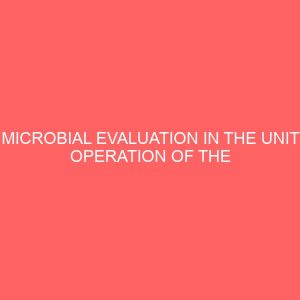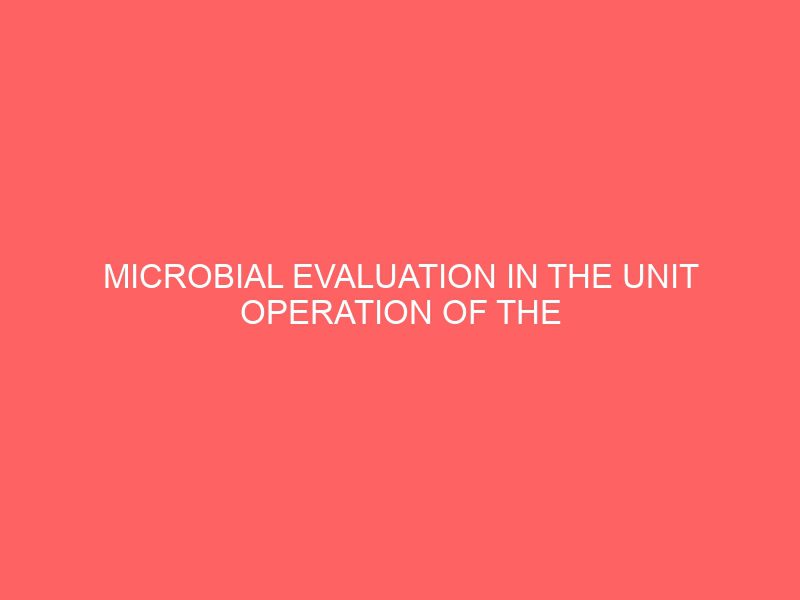Description
ABSTRACT
This study was conducted to evaluate the microbial status of fresh and processed cane rat along the unit operation in some selected markets in Benin City, Nigeria. Fresh cane rats were obtained from the different markets which are from the three local government areas that is, Oredo, Egor and Ikpoba-Okha which make up Benin City, while the Control cane rat was processed in the Faculty of Agriculture laboratory. Direct plate method was done by taking swabs with a sterile swab stick at different points during the processing line was used for the microbial evaluation to determine the total bacteria and fungi (mould) count of the various cane rat samples. The result shows the total bacteria population from the various markets as follows: Control (191cfu/g), New Benin (199cfu/g), Uwa (192cfu/g) and Abico (220cfu/g). While the total fungal count, was in New Benin (41cfu/g). There was however, no fungal recorded for samples from other markets and the Control.
The mean microbial population along the processing line shows that the whole unprocessed cane rat has the highest microbial count of 60.75cfu/g, followed by after washing 59.50cfu/g, and after evisceration 47.00cfu/g and after scalding 33.25cfu/g. The analysis of variance showed that there was no significant difference (P<0.05) between the samples from various markets in terms of microbial load. Two bacteria were isolated, identified and characterized. They are staphylococcus albus and Streptococcus specie while one fungal organism Aspergillus specie was identified in the cause of the study. There was however significant difference (P<0.05) in the microbial population along the processing line. TABLE OF CONTENTS Title Page --------ii Abstract--------iii Acknowledgement -------iv Certification--------v Dedication--------vi Table of Context-------vii List of tables------- -ix List of Figures -------x CHAPTER ONE INTRODUCTION-------1 1.1Objectives of the Research -----3 CHAPTER TWO LITERATURE REVIEW------4 2.1Characteristics of the Cane Rat----4 2.2Distribution and Habitat of the Cane rat---5 2.3Physical Description------6 2.4Haematological and Biochemical Values in the Cane Rats-7 2.5Reasons for Losses in Captive Cane rats---9 2.6Gastrointestinal Helminthes-----10 2.7Blood Protozoan Parasites-----12 2.8Economic Potentials of the Cane rats----13 2.9Nutrients Derived from Cane rat Meat---14 2.10Processing of Cane Rat Meat -----14 2.11Microbiology of the Cane rat Meat ----15 2.12 Factors that affect the Growth of Microorganisms in Cane Rat Meat 16 2.12.1 Temperature-------16 2.12.2 pH --------17 2.12.3Nutrients-------17 2.12.4Water Availability ------17 2.12.5Spoilage of Meat ------17 CHAPTER THREE MATERIALS AND METHODS-----19 3.1Sample Collection ------19 3.2Preparation of Agar------20 3.2.1Potato Dextrose Agar (PDA) for mould evaluation:--20 3.2.2Nutrient Agar (NA) for bacterial evaluation:---20 3.3Microbiological analysis-----20 3.4Characteristics of the bacterial isolates---21 3.5Identification of Bacterial and fungal Isolates--21 3.6Statistical analysis------22 CHAPTER FOUR RESULTS--------23 CHAPTER FIVE DISCUSSION -------33 CHAPTER SIX CONCLUSION AND RECOMMENDATION--35 6.1Conclusion -------35 6.2Recommendation ------35 REFERENCES-------36 APPENDIX --------39 LIST OF TABLES Table1: Bacteria characteristics, colonial count (cfu/g), classification and the probable organisms from New Benin Market…………....................23 Table 1b: Fungi characteristics, colonial count (cfu/g), classification and probable organisms of samples from New Benin Market…………….24 Table 2: Bacteria characteristics, colonial count (cfu/g), classification and probable organisms from samples taken from Uwa Market……………25 Table 3: Bacteria characteristics, colonial count (cfu/g), classification (Gram reaction), and the probable organisms obtained from swab samples taken from AbicMarket……………………………………………….26 Table 4: Bacteria characteristics, colonial count (cfu/g), classification (Gram reaction), and the probable organisms obtained from swab samples of the Control experiment taken from Faculty of Agriculture………….27 Table 5: The summary of the results obtained for Bacteria count………………28 Table 6: Mean from the various sampling points………………………………29 LIST OF FIGURES Figure 1: Bacteria growth count of each of the sampling points at various points along processing line………………………………………….. 30 Figure 3: Unit operation of cane rat processing showing the identified Critical Control Points (CCPS)……………………………………..…31 CHAPTER ONE INTRODUCTION Globally, wildlife has great potentials for meat production and serves as an important source of the highly desired animal protein to the people of Africa, both in urban areas and rural communities (Fonweban and Njiwe, 1990). The preference for such merit or the meat of commercially available game animals is widely accepted (Baptist and Mengah, 1986). However, with ever increasing human population and obvious protein shortage in Africa, there is the need for an exploration of other means to provide readily accepted meat or short terms basis. Among the wild rodents, the cane rat, or cane rat or cane cutter is the most preferred (Goffey, 1981). Cane rat (Thryonomys swinderianus) is a wild hystricomophic rodent widely distributed in the African sub-region and exploited in most areas as a source of animal protein (NRC, 1991). Being the most preferred and one of the most expensive meats in West Africa including Nigeria, Togo, Benin, Ghana and Cote d’ Voire (Baptist and Mensah, 1998; Asibey and Addo, 2000), it constitutes to both local and export earning of most West Africa countries (NRC, 1991; Yeboah and Adamu, 1995). To alleviate this problem, attempts are being made in the sub-regional to domesticate the grass cutter (NRC, 1991; Addo, 2002) and make it more readily available, gain economic benefit and also reduce the environmental destruction that accompanies its collection from the wild. Efficiently producing grass cutters in captivity demands that adequate nutrition is provided to ensure high productivity. However, grass cutter especially in the dry season poses a major challenge to produce in Nigeria. Despite the role cane rat rearing plays in the livelihood of most Nigerians and the contribution to the daily protein intake, if continued, cane rat meat cause a source of food-borne illnesses especially under the condition in which animals are handled, slaughtered, transported and sold in Nigerian markets. Prescott, et al., (2002) shown that food items especially meat, are not only of high nutritional value to those who consume them but often are ideal culture media for microbial growth, meat is one of the most perishable foods, indicates composition is ideal for growth of a wide range of spoilages bacteria (Mayr, et al., 2003). Mukhopadhyay et al., (2009) also reported that fresh raw meat like cane rat meat has been implicated for a number of meat borne infections and intoxications in several countries. This is because both pathogenic and non-pathogenic organisms live in the gastro intestinal tract (GIT) of cane rat which can be transformed onto the meat under faulty and poor processing conditions. The advocacy for domestication of cane rat becomes stronger as it accepts indoor housing with about 90% of animals acclimatizing to domestic housing within three months (Asibey and Addo, 2000), with the acceptability of the meat among Nigerians, regardless of their religious of faith and social status further underscores the importance of domesticating this animal. Due to the insatiable demand for the cane rat meat, some people have resorted to use poisons as bait to catch wild cane rat and this poses a serious health threat. The inadequate supply of animal protein in developing countries has been attributed to inadequate production and high cost of conventional sources of animals protein (poultry, goat, meat, beef, mutton and pork) and cane rat meat, hence, an average Nigerian consumes only about a quarter of his minimum daily protein requirement (Oke, et al., 2004). To this end there has been increase in the consumption of bush meat. This increase has bridged the supply and demand protein gap (Abulude, 2004). 1.1Objectives of the Research The objectives of this study are to: Determine the microbial status of fresh cane rat Determine the critical control points at which microbes are likely to contaminate the fresh cane rat along processing line. Isolate, identify and characterize the micro organisms present in the fresh cane rat during processing.







